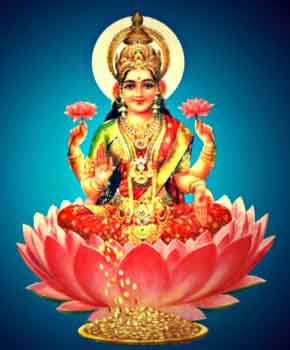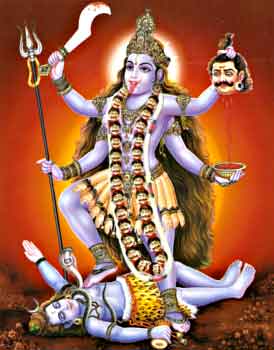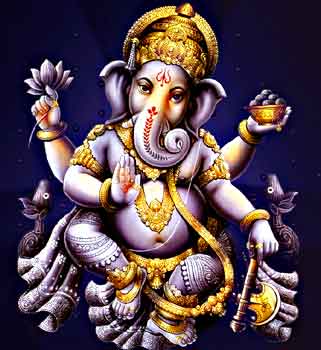 The concepts in Narada Purana can be divided into Sarga, theory of Time, Terrestrial Globe, Origin of Puranas, and Vedangas in Narada Purana. Sarga denotes creation of the universe. According to Narada, the Shakti of the all-pervading Lord Vishnu, is Bhava Abhava, Vidya, Avidya, Uma, Laksmi, Kali, Prakrti, are the causes of creation manifesting itself in three forms being Prakrti Purusha and Kala. The nature when disturbed gave birth to the universe and ending with Pancabhutas. He says that Brahma, Vishnu and Siva, were formed to execute trio functions of formation, conservation and demolition of the cosmos. After earth`s development from the Prakrti, Brahma created birds and animals, gods and human beings.
The concepts in Narada Purana can be divided into Sarga, theory of Time, Terrestrial Globe, Origin of Puranas, and Vedangas in Narada Purana. Sarga denotes creation of the universe. According to Narada, the Shakti of the all-pervading Lord Vishnu, is Bhava Abhava, Vidya, Avidya, Uma, Laksmi, Kali, Prakrti, are the causes of creation manifesting itself in three forms being Prakrti Purusha and Kala. The nature when disturbed gave birth to the universe and ending with Pancabhutas. He says that Brahma, Vishnu and Siva, were formed to execute trio functions of formation, conservation and demolition of the cosmos. After earth`s development from the Prakrti, Brahma created birds and animals, gods and human beings.
About Pratisarga, Narada narrates that the period of two Parardhas (hundred thousand billions of Brahma years) is Vishnu one day`s time. The same applies for the night. Vishnu, on waking up from his sleep, takes the form of Brahma and creates the universe, which during his nighttime stay water submerged. Since Vedic times the word `Kala` was used to mean `time`. Narada specifies the four yugas respectively Kreta, Treta, Dvapara and Kali. With the period of sandhya and sandhyamla and these four yugas cover a period of twelve thousand celestial years.
The Mahabharata and several Indian Puranas like the Vayu, Matsya, Karma, Linga, Garuda and Narada give description of the nature of the four yugas. According to the Narad Puran Dharma (righteousness) prevails in all its perfection and stands on all the four legs in the Kreta yuga and declines by a quarter in the successive yugas and in Kali only one quarter of Dharma remains. Narada also thinks the same way.
The Naradiya descript the kali age as the era of crimes. Dharma would stand on a single leg. The four varnas would avoid their duty. Dharma and Veda would be business like. With fake pride Sraddha would be performed. Gifts would be gifted to the unfit. The maximum life-span would be sixteen years. The world would be bereft of welfare as all virtues will be lost. Those who are devoted to Hari or Siva would unaffected by this Yuga. According to Narada, thousand yugas make a day of Brahma which is comparable to the period of fourteen Manus. Each era of Manu has its own set of gods, sons, Indra and Saptarsis. Narada names only the Indra`s and gods belonging to the fourteen epochs. Wealth, brilliancy, and valour are equally distributed.

Earth`s sphere is an imperative aspect talked about in Narada Purana. According to sage Narada, the earth encompasses seven islands, each succeeding one being two times that of the previous one, seven oceans bordering it.
There are several theories about the origin of the Puranas. According to Narada Purana the theory consisting of four lakh verses is known as Brahmanda. This is further divided into the eighteen Puranas by Vyasa.
Vedangas are also known as limbs of the Vedas. Knowledge is of two kinds, higher and lower. The higher is related to knowledge of Brahman, whereas the lower is related to four Vedas, Siksa, Kalpa, Vyakarana, and Nirukta and so on. Thus Siksa and Chandas assist reading and recitation of the Vedas. Nirukta and Vyakarana were useful for comprehending, Kalpa and Jyotisa for practicing the knowledge. The Vedangas appears to have its origins in the Britihmanas and the Aranyakas. Some texts were in sutra style.
Shiksa in Narada Purana deals with prominence of the Samhita Veda and instructions for accent accuracy. Narada describes the shiksa concept vividly laying down regulations for Vedic recitation and classical Sanskrit with exact inflections. The art of music and other associated art have also been elucidated. In a broad-spectrum Narada suggests some rules and a methodic living to be observed.
Vyakarana or the science of grammar originated in connection with the Veda. Narada says that Vyakarana is the mukha (face) of the Veda and deals with the topics like masculine, feminine gender, case, and compound and so on.
Here Narada does not give the tradition of grammar though a brief abstract of some work. This section appears to have been written after the restoration of Panini by Bhartrihari. Narada`s approach to syntax is found to be less methodical, as he majorly gives simple examples without stating the rules.
Right from the day man came into view on this planet he is engaged in efforts to disentangle natural mysteries. It is this same urge that led him to the science of the stars. The beginning of Jyotisastra in India can be traced back to the Vedic period. Jyotisastra is made up of three important parts Ganita, Phalita, and Jataka. Among the eighteen Puranas, the Narada Purana can be singled out as the text that compacts all the three branches of Jyotisastra in specifically.
 According to the Narada Purana, the portion related to Jyotisastra is a theory of Brahma`s work in 4,00,000 verses divided into astronomy, horoscopy and natural astrology.
According to the Narada Purana, the portion related to Jyotisastra is a theory of Brahma`s work in 4,00,000 verses divided into astronomy, horoscopy and natural astrology.
Concepts of Narada Purana have section on three beliefs that is Vaishnavism, Shaivism and Shaktism. According to the Narada Purana, Brahma, Vishnu and Shiva are only three manifestations of the Supreme. They perform the functions of creation, preservation and destruction of the universe respectively. Narada enumerates the ten incarnations of Vishnu. Among the ten incarnations of Vishnu, Narada gives details of three incarnations; they being Lord Rama, Narsimha and Lord Krishna.
The worship of Shiva is considered as the oldest form of Indian religion.
In the Narada Purana, Shiva is described as a known god, though compared to Vishnu, he holds a lower rank. He is kind to his devotees. His disgrace brings wreckage
Only Lord Ganehsa is dealt with in detail in Shiva`s family. The Shakti faction can be traced the worship of Mother-Goddess in the pre-Vedic age.
Mother cult is an essential part in the concepts of Narada Purana. The prominent female deities mentioned are Radha, Durga, and Lakshmi. According to the Narada Purana, Radha is believed to have been born from Krishna`s body. Laksmi is revered as the goddess of gold and wealth. Various embodiments of Lakshmi and Durga have been enumerated. Durga is considered as the main basis of all creation and of all the goddesses.
Concepts in Narada Purana do have similarities and dissimilarities with other religious texts. Yet again in some case like that of Shaivism and few conceptions there are certain descriptions which can be found only in Narada Purana.



















